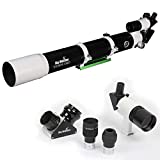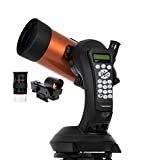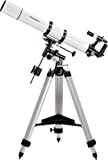Top moon viewing telescopes reviewed & buying guide
If you’re short on time and you just want to find the best moon telescope, this short paragraph should help you get exactly the model you need. According to our findings, the Sky-Watcher ProED S11120 is the best because it comes with virtually any feature you might be looking for in a product in this line. Based on the reviews it has garnered, it appears that this unit is a good telescope to see planets as well as the moon, especially as it has a 100mm aperture and a 900mm focal length. What’s more, an aluminum carrying case is part of the deal with this unit, which means that you’ll be able to benefit from enhanced portability. Many owners have reported that it is quick to set up. If the Sky-Watcher ProED S11120 is unavailable, your second option should be the Celestron NexStar 4 SE 11049.
Comparison table
 Our Top Choice
Our Top Choice
The 100mm aperture of this model makes it a fine choice for anyone who wants to examine celestial bodies from up close. The dual-speed focuser is ideal for adjusting and fine-tuning your image, so it is safe to say that this model is a good instrument for education and learning. The superior versatility presented by the existing eyepieces makes it an optimal pick for anyone who wants to learn more.
Some slight chromatic aberrations are to be expected, according to some users.
A versatile and easy to use telescope, ideal for learning.
 2nd Best
2nd Best
Aligning and locating objects in the sky is performed easily, due to the StarPointer finderscope that comes attached to this unit. A few useful accessories are provided with your purchase, such as an optical tube, a fork arm mount that is quick to release, and an accessory tray that comes in handy while you run your observations. The 40,000 database with celestial objects is useful for learning.
You will not get rechargeable batteries, and you will need to buy them separately.
A more than decent model, packed with useful extras.
Also To Consider
Aperture and focal length are two important things you should notice in any telescope. In this unit, both are more than decent, as it comes with a 90mm aperture and a 910mm focal length. The equatorial mount that comes along with the telescope comes in handy for eliminating Earth’s natural rotation from your observations. The Starry Night instructional software is a nice extra.
Some stability issues may appear when you extend the legs of the mount.
A telescope that offers more than decent quality for the right price.
If you’re looking to purchase a telescope to see planets and stars, as well as the moon, you’re in the right place. If this is your first scope, you’re probably feeling a bit confused as to which one you should pick out of the myriad available nowadays. We’ll make sure to tackle some of the crucial factors that you might have to bear in mind when prospecting the market for such an optical device. Check out our comprehensive telescope guide.
What type are you looking for?
The first matter that you need to address is the actual design that you might be searching for. Newtonian reflectors are great if you wish to take a peek at nebulae, galaxies, as well as planets and the moon. Refractors are another option, as are Dobsonians and catadioptric telescopes.
While the first two make great choices for people who want to look at the moon and other planets in our galaxy, the last two are perfect for galaxies, nebulae, as well as some serious planetary and lunar observing. You’ll definitely be able to see Saturn through telescope of this kind.
Even though some catadioptric models can cost a pretty penny, they take the cake when it comes to performance and versatility as they have a convenient design which allows them to be portable and they gather enough light to allow you to look at planets. Dobsonians are those that are capable of collecting as much light as possible, which is why you will be able to utilize one of these for observing faint celestial objects.
Aperture and focal length
Both the focal length and the aperture are equally important, although the latter seems to bother most prospective buyers. The simplest way of putting it would be to tell you that a bigger aperture is always better as you’ll be able to look at a wider picture and get a clear image. With a bigger aperture, the best telescope for planets and moon will be capable of gathering more light, which is why you will have the freedom to look at deep-sky objects, nebulae, as well as galaxies.
As for the focal length, while some argue that it might be of minor importance when compared to the aperture, it still matters a great deal. The longer it is, the bigger will the objects look when you are focusing on them.
Keep in mind that, with a higher focal ratio, you will be able to study the small characteristics of the Moon, but the speed of the telescope might be lower when compared to that of a model with a low focal ratio. The latter is known as a fast telescope.
Magnification and computer control
Unlike like other optical devices such as microscopes, the magnification of some telescopes doesn’t affect the advantages it may offer you. In fact, the eyepieces that are used to magnify celestial objects can even be replaced and upgraded later on, if you suddenly decide that those that came with the main unit aren’t capable of doing it for you any longer.
Typically, the bigger the magnification, the better, but it’s not a universal rule that can be applied to all cases. In fact, most of the telescopes to see stars that come with higher magnification levels can cost a fortune, so you might have to reconsider your purposes.
As for computer control, it’s always handy when a device can do your job for you. In this sense, the telescope can automatically point to interesting objects that are visible at a given time. You’ll have to set the date and time on your device in order to activate this feature, and most of the units that come with it are GPS-enabled.
5 Best Telescopes to see the Moon (Reviews) in 2024
With the right product, you’ll be able to look at a plethora of celestial objects, not just the moon. Plus, depending on the features that it comes with, a telescope to see Mars can be used for the same goal. If you haven’t made up your mind on a particular model just yet, perhaps you might want to consider the following ones especially as they’ve garnered the best telescope to see the moon reviews.
Contents
1. Sky-Watcher ProED 80mm Doublet APO Refractor Telescope

With its 100mm aperture and 900mm focal length, it’s safe to say that this refractor telescope can serve you when you need it the most. It comes with 20mm and 5mm 1.25” eyepieces, a 2” dielectric diagonal, and an 8X50 RA viewfinder. What’s more, it should be noted that nothing will be able to stop you from taking this device on the road as it even comes with an aluminum carry case.
The only thing that seems to be missing about the Sky-Watcher ProED S11120 is a tripod or a mounting system of some sort as the model comes all on its own.
Pros
This 100mm APO refractor telescope with an extra-low dispersion (ED) Schott glass delivers a dependable performance to enable you to see celestial objects up close with ease.
The dual-speed, 2-inch, Crayford-type focuser enables the fine-tuning of the images that you see so you can view the details for learning and educational purposes.
The scope ships with 1.25-inch eyepieces with magnifications of 5mm and 20mm for versatile viewing options, whether you want to do fine detail or gross surface studies.
The 8×50 RA viewfinder enables you to locate the celestial targets easily so you would not need to know first hand the exact spot on which to aim the scope every time.
The tube-ring attachment hardware provides an efficient means of mounting the scope onto a compatible tripod while the aluminum carrying case facilitates the storage and transport of the instrument, for a lifetime of astronomical viewing experience and enjoyment.
Cons
This ED refractor tends to provide a color correction that is heavier on the blue side, which leaves a pinkish tinge when viewing the extremely bright objects.
Buy from Amazon.com
2. Celestron 11049 NexStar 4 SE Computerised Telescope

An optical tube, a quick-release fork arm mount, as well as an accessory tray are all provided in the package, and they increase the overall value offered by the unit. The only detail that might bother you is that, unlike other telescopes out there, this one is priced just under five hundred dollars, which means that it might not be the right choice for a beginner with a limited budget.
Nonetheless, the model does come with a 40,000-object database and 200 user-definable objects, which means that it will allow you to benefit from a quick and convenient alignment process.
Pros
This 4-inch Maksutov-Cassegrain telescope features the exclusive StarBright XLT high transmission coatings on its optical components, which help deliver maximum light gathering capability for vivid and bright images with good detail levels.
The standard StarPointer finderscope enables the effortless alignment and accurate locating of celestial objects so you would not need to do plenty of research first before attempting to use the device.
The quick-release fork arm mount makes it possible to fix the optical tube assembly to a good-quality tripod for stability, while the accessory tray holds your viewing essentials within easy reach, with all the components coming together easily so there’s no need for special tools or skills.
The SkyAlign feature lets you use three bright objects in the sky as reference points for a quick and hassle-free alignment every time.
The telescope also comes with a database of nearly 40,000 objects as well as 200 user-definable objects and more information on over 200 celestial objects, which is very useful when doing an in-depth research and study.
Cons
The small size of the scope tends to limit your deep-sky viewing capacity. The scope does not ship with rechargeable batteries.
Buy from Amazon.com
3. Orion 9024 AstroView 90mm Equatorial Refractor Telescope

An equatorial mount and an EQ-2 adjustable tripod are part of the deal with this product, which means that you’ll get plenty of chances to try your manual tracking abilities. Considering the fact that this particular model comes with a Starry Night astronomy software, it can help you with your learning curve.
Something other that needs to be noted about this Orion option is that it can also be utilized for terrestrial viewing as long as you decide to purchase a separate correct-image diagonal. Not all telescopes in this line can enable you to do that.
Pros
Perfect for beginners who want a powerful, high-quality refractor telescope, this model comes with a decent aperture of 90mm for good viewing but without the hefty price tag.
Get crisp, vivid views of the objects in the night sky thanks to the large-enough aperture that enables the scope to collect a premium amount of light from the objects under observation to give you bright images.
The supplied EQ-2 adjustable tripod and equatorial mount work well together to facilitate the manual tracking of celestial objects in slow motion for speed control and precision.
The 90-degree mirror diagonal makes it comfortable to do nighttime viewing through the eyepiece so you can see objects easily while being compatible with a separately bought correct image diagonal.
The telescope comes with fully illustrated instructions to make assembly quick and easy, while the included accessories that include two Sirius Plossl eyepieces, the exclusive Starry Night planetarium software for your computer, and the 6×30 optical finderscope guarantee out-of-the-box functionality.
Cons
When the telescope legs are fully extended, the EQ-2 equatorial mount tends to be a little wobbly as you do the focusing, which is a usual thing with telescopes of this size in this price range.
Buy from Amazon.com
4. Celestron 21037 PowerSeeker 70EQ Refractor Telescope

Nonetheless, it can provide decent images of the moon. However, the PowerSeeker 21037 proves its worth under many circumstances as it even comes with a correct-image diagonal that will allow you to use it for terrestrial observation. A tripod made of aluminum can be found in the box, and the first edition of the TheSkyX software is also part of this deal.
From what we have gathered by sifting through the reviews garnered by this alternative, it appears that buyers think that it is well worth the money and that it can be thought of as an excellent beginner level choice.
Pros
Outfitted with surprisingly good optics, this telescope provides an aperture of 70mm to allow it to gather enough light so viewed images are bright and crisp for visual enjoyment and interesting study.
The supplied Barlow lens triples the magnifying power of the included eyepiece, which enables you to see clearly and in detail when viewing objects in the night sky.
The 1.25-inch Star erect image diagonal enables you to view images comfortably as they are right side up and not upside down, helping you do extended studies as needed.
The EQ mount comes with slow motion controls to enable you to do measured, precision tracking of celestial objects as they journey across the night sky to follow their path.
The telescope needs no special tools or skills to assemble and setup so you can start observing the targets the minute the device has been put together.
Cons
Some customers don’t really care much for the included accessories because they had expected more but they all agree that for the price, this product is good enough.
Buy from Amazon.com
5. Gskyer Astronomical Refracting Telescope for Kids
Kids will love this telescope that appears to have been made mainly with their curiosity in mind. While it may be a model created for children and novices in general, the optics quality on this telescope is beyond reproach. The fully coated lens helps in the delivery of a bright clear picture.
Furthermore, the transmission coatings used will protect your eyes, and you will be able to explore celestial bodies like the moon without any issues. The model is provided with two eyepieces, and features such as the mounting bracket and the crosshair lines are there to help the user identify objects right away.
An interesting aspect is that it also comes with an adapter for your phone and a wireless camera, which means that you can record what the telescope sees. Nothing seems to be amiss, as even an adjustable tripod is included in the package.
Pros
A 70mm telescope, this model from Gskyer, is the ideal choice for beginners and children in particular, as it offers reliable quality at an affordable price.
Due to its 400mm focal length, the telescope is capable of delivering excellent results, so you will never feel like you’re looking at the night sky through a model designed for children.
Its 3x Barlow lens extends the magnification the telescope is capable of, up to 120x, which makes it an excellent choice for exploring the moon.
A travel bag is supplied with your purchase, and that helps you carry the telescope anywhere with you as the compact body and the accessories all fit inside with ease.
The eyepieces are designed to be easy to swap, and the overall optics quality ensures that you will encounter no issues with eye fatigue when using the telescope.
Cons
If there is one downside to this otherwise useful telescope, that would be the lack of in-depth instructions that would have made the learning process easy.
Buy from Amazon.com
Unavailable products
Orion 10029 StarBlast 90mm Altazimuth Travel Telescope

The altazimuth mount boasted by this model comes with slow-motion controls which make object tracking as effortless as possible. Whether you’re looking to purchase a new moon telescope for yourself, your kids, or offer it as a gift to someone close, the StarBlast might just be the right answer to all of your questions.
While there haven’t been significant complaints with regard to this option, it is still worth noting that some buyers say that it is a bit too heavy to be carried for long distances.
Pros
This is a terrific grab-and-go refractor telescope designed for beginners and seasoned hobbyists alike who want to enjoy fantastic nights of astronomical observations without too many frills in their viewing instrument.
The 90mm aperture enables the scope to gather sufficient light for clear and bright views of different images through the supplied 1.25-inch eyepieces.
The altazimuth mount is quite easy to operate as it features slow-motion controls that facilitate the easy tracking of objects as they follow their paths across the night sky.
Get fascinating views from this remarkable travel telescope that enables you to take it to campouts and family road trips.
This telescope comes with a 90-degree star diagonal that enables a comfortable viewing so you can see images right side up and do an intensive study of celestial targets at a normal viewing position.
Cons
One customer was disappointed that the assembly instructions that came in the package were not for this specific model.
Bibliography:













